Abstract
Background:
Emphasis on enhancing baseball pitch velocity has become popular, especially through weighted-ball throwing. However, little is known about the physical effects or safety of these programs. The purpose of this study was to examine the effects of training with weighted baseballs on pitch velocity, passive range of motion (PROM), muscle strength, elbow torque, and injury rates.
Hypothesis:
A 6-week weighted ball training program would result in a change in pitching biomechanical and physical characteristics.
Study Design:
Randomized controlled trial.
Level of Evidence:
Level 1.
Methods:
During the baseball offseason, 38 healthy baseball pitchers were randomized into a control group and an experimental group. Pitch velocity, shoulder and elbow PROM, shoulder strength, elbow varus torque, and shoulder internal rotation velocity were measured in both groups. The experimental group then performed a 6-week weighted ball throwing program 3 times per week using balls ranging from 2 to 32 ounces while the control group only used a 5-ounce regulation baseball. Both groups performed a strength training program. Measurements were then repeated after the 6-week period. Injuries were tracked over the 6-week training program and the subsequent baseball season. The effect of training with a weighted ball program was assessed using 2-way repeated-measures analysis of variance at an a priori significance level of P < 0.05.
Results:
Mean age, height, mass, and pretesting throwing velocity were 15.3 ± 1.2 years (range, 13-18 years), 1.73 ± 0.28 m, 68.3 ± 11 kg, and 30.3 ± 0.7 m/s, respectively. Pitch velocity showed a statistically significant increase (3.3%) in the experimental group (P < 0.001). There was a statistically significant increase of 4.3° of shoulder external rotation in the experimental group. The overall injury rate was 24% in the experimental group. Four participants in the experimental group suffered elbow injuries, 2 during the training program and 2 in the season after training. No pitchers in the control group were injured at any time during the study.
Conclusion:
Performing a 6-week weighted ball throwing program increased pitch velocity. However, the program resulted in increased shoulder external rotation PROM and increased injury rate.
Clinical Relevance:
Although weighted-ball training may increase pitch velocity, caution is warranted because of the notable increase in injuries and physical changes observed in this cohort.
Keywords: elbow, shoulder, external rotation, varus, valgus, torque
Baseball pitching injuries continue to occur at an alarming rate.5 Conte et al5 recently reported on injury trends in Major League Baseball (MLB) from 1998 through 2015 and noted that the average annual cost of players on the disabled list (DL) is now over $423 million. The authors noted that number of days on the DL have increased year to year, with the average annual number of ulnar collateral ligament (UCL) reconstructions increasing significantly.5 These injury trends are not isolated to professional baseball. Hodgins et al14 reported a 193% increase in the number of UCL reconstructions in the state of New York from 2002 to 2011, with a significant trend for increased frequency of reconstructions in youth baseball players.
There has been recent increased emphasis on pitch velocity within the amateur and professional levels of baseball. According to Pitch/FX data, the mean fastball velocity in MLB has gone up each year since tracking began, from 90.9 mph in 2008 to 93.2 mph in 2017.12 Previous studies have shown both a correlation between increased pitch velocity and increased elbow stress15 and elbow injury rates.2,4 Thus, it is not surprising that injury rates continue to increase in a nearly linear fashion with increased average pitch velocity in professional baseball.5
This emphasis on pitch velocity has resulted in the development of several velocity enhancement programs often marketed on the internet to baseball pitchers. These have become increasingly popular with amateur baseball players looking to enhance their playing potential in the future. One of the most popular forms of velocity enhancement programs is using underweight and overweight weighted baseballs. These programs have been theorized to enhance throwing mechanics, arm speed, and arm strength, claiming to enhance pitch velocity by 5 mph (2.2 m/s) or more.
Several studies have shown that weighted baseball training programs are effective at enhancing velocity.6-8,11 Fleisig et al13 reported kinematic and kinetic differences between pitching with regulation 5-ounce baseballs and underweight and overweight baseball balls ranging from 4 to 7 ounces. The authors found steady decreases in arm velocities, trunk velocities, and arm forces as ball weight increased from 5 to 7 ounces. No studies have investigated the physical changes of the arm created by weighted ball training nor whether such training programs increase the risk of injury.
Thus, the purpose of this study was to determine the effectiveness of a 6-week weighted ball training program on enhancing pitch velocity while also quantifying the effects on biomechanical and physical characteristics of the shoulder and elbow. In addition, injury rates were monitored to determine the potential safety of this training program.
Methods
This study was approved by the institutional review board of St Vincent’s Hospital (Birmingham, AL). Baseball pitchers between the ages of 13 and 18 years were recruited for the study during the offseason. Recruits were excluded if they had incurred an injury to their throwing arm in the previous 12 months. Prior to data collection, each participant provided written informed consent and completed forms about their medical history and baseball background. Participants younger than 18 years provided written assent and their legal guardians provided informed consent. A total of 38 baseball pitchers met these criteria and agreed to participate. Participants were randomly divided into a training group (n = 19) and control group (n = 19). Power analysis revealed a minimal sample size of 12 participants per group to detect a 2-mph (0.9 m/s) change in ball velocity.
On completion of the enrollment phase, baseline measurements of shoulder passive range of motion (PROM), elbow PROM, and shoulder strength were taken for the dominant arm of each participant. Reliability of range of motion and strength testing was assessed in a pilot group of 10 participants. Three separate measurements were made for each variable, and the intraclass correlation coefficient (ICC) was calculated for each participant’s measurements. All measurements exhibited strong reliability (ICC > 0.98). The order of measurements performed was randomized prior to data collection.
Measurements of passive shoulder flexion, external rotation (ER) (Figure 1) and internal rotation (IR) at 90° of abduction and 10° of horizontal adduction, elbow flexion, and elbow extension were assessed for 1 repetition using previously established methods.21,25,26 Measurements for shoulder IR were performed by stabilizing the scapula via the coracoid process as previously described (Figure 2).26 Two examiners were consistently used for all measurements: one to position the extremity and the other to align and read the goniometer. The examiner positioning the extremity was blinded to the results. Both were blinded to the group for each participant.
Figure 1.
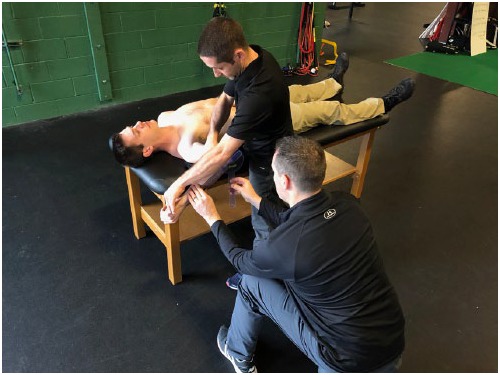
Passive range of motion measurement of shoulder external rotation at 90° of abduction with the arm on a towel roll.
Figure 2.
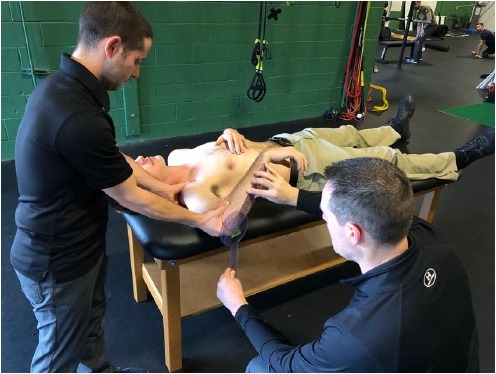
Passive range of motion measurement of shoulder internal rotation at 90° of abduction using the coracoid stabilization technique with the arm on a towel roll.
Strength was measured using a handheld dynamometer (Lafayette Manual Muscle Tester; Lafayette Instruments) using previously established methods (Figures 3-6).17,18,20,22 Two 5-second trials of each motion were performed, and the mean peak newton (N) of force of each were recorded.
Figure 3.
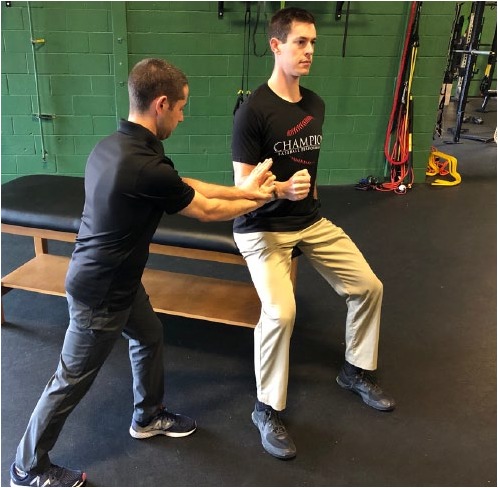
Strength measurement of shoulder external rotation at 0° of abduction using handheld dynamometry.
Figure 4.
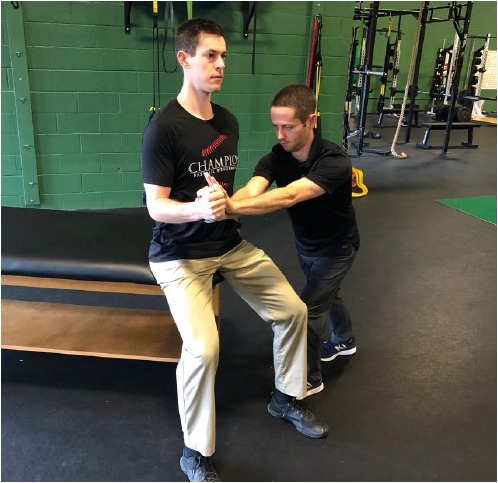
Strength measurement of shoulder internal rotation at 0° of abduction using handheld dynamometry.
Figure 5.
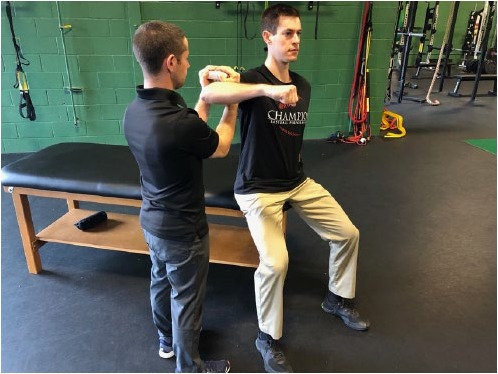
Strength measurement of shoulder abduction at 90° of abduction using handheld dynamometry.
Figure 6.
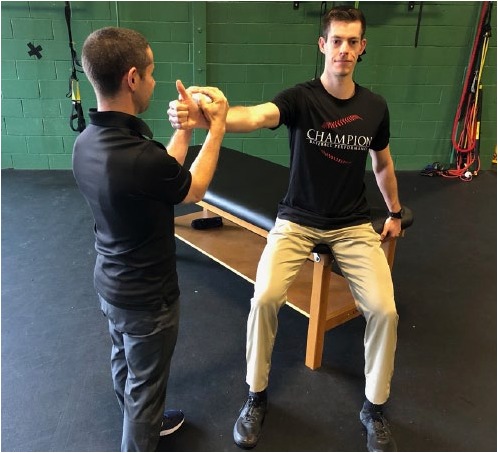
Strength measurement of shoulder elevation in the scapular plane at 90° of abduction using handheld dynamometry.
The participant then underwent baseline velocity testing. He was instructed to go through his normal warm-up routine consisting of stretching and nonthrowing and throwing drills. Each participant concluded his preparation by throwing as many warm-up pitches with a standard baseball as he desired. Once the participant indicated he was ready to begin the analysis, he pitched 10 fastballs with a 5-ounce standard regulation baseball from a standard pitching mound. For each pitch, ball velocity was measured using a radar gun (Stalker Radar), while elbow varus torque and shoulder IR velocity were measured using an elbow sleeve with an embedded inertial measurement unit (mThrow Sleeve; Motus Global). A previous study has shown this sleeve to correlate well with standard motion capture in measurements of elbow varus torque (r = 0.93) and arm rotational speed (r = 0.85).3
After baseline testing, both groups were allowed to participate in a supervised baseball offseason strength and conditioning program. All participants engaged in a throwing program but were not allowed to practice pitching off a mound. In addition, the training group performed a 6-week weighted ball throwing program in January and February of the baseball offseason. The program was performed 3 times per week (Table 1). The 6-week program was developed based on experience and is similar to, if not more conservative than, commonly performed commercially available programs for baseball pitchers. Over the course of the 6-week program, throws were performed from 3 common baseball drill positions: knee, rocker, and run and gun. The knee throws were performed with each participant half kneeling on his back knee, facing sideways from the target. He was instructed to turn and throw while remaining in the half kneel position. Rocker throws were performed with the participant standing sideways to the target. He was instructed to rock forward onto his stride leg and then back on his rear leg before turning and throwing. The run and gun throws were performed by starting with a running crow hop and throwing into a target. Participants were instructed to throw at 75%, 90%, and 100% of their full intensity depending on the week of the training program. Throws were performed from each position at each training session with a 2-, 4-, 6-, 16-, and 32-ounce ball. One set with each weighted ball was performed with the outlined repetitions (Table 1), with a brief 10-second rest between each set. The control group was not allowed to throw with any underload or overload balls in their offseason program.
Table 1.
Six-week weighted ball training programa
| Training Position |
|||||||
|---|---|---|---|---|---|---|---|
| Knee |
Rocker |
Run and Gun |
Total Volume of Throws (n) |
||||
| Intensity b (%) | Reps c | Intensity b (%) | Reps c | Intensity b (%) | Reps c | ||
| Week 1 | 75 | 3 | 15 | ||||
| Week 2 | 90 | 3 | 75 | 3 | 30 | ||
| Week 3 | 100 | 2 | 90 | 3 | 75 | 2 | 35 |
| Week 4 | 100 | 2 | 100 | 2 | 90 | 3 | 35 |
| Week 5 | 100 | 2 | 100 | 2 | 100 | 3 | 35 |
| Week 6 | 100 | 2 | 100 | 2 | 100 | 3 | 35 |
The 6-week weighted ball training program was performed 3 times per week. One set of throws was performed with the outlined reps and intensity that progressed each week. Throws were performed from each position at each training session with each of 5 different weighted balls (2, 4, 6, 16, and 32 ounces).
Intensity denotes the instructed intensity of performed throws.
Reps denotes the number of repetitions performed.
All measurements were repeated after 6 weeks for both groups. The participants went on to pitch as normal through the spring and summer baseball seasons. After concluding the season, participants filled out a survey to report their injury rates. Injuries were defined as any abnormal amount of shoulder or elbow pain causing medical attention and/or loss of playing time.
Statistical analysis was performed using SAS v9.4 (SAS Institute). Measurement reliability of elbow stress and shoulder IR velocity, as measured by the mThrow sleeve, was tested by calculating ICCs among the 10 trials of each participant’s pre- and posttraining test sessions.
Baseline demographic, anthropometric, range of motion, strength, velocity, and elbow stress were compared between cases and controls using Student t tests. There were no differences in any of these measures at baseline with the exception of the strength of the dominant shoulder’s abduction (control, 124.5 N; training, 100.9 N; P = 0.04). Overall, the pitchers were (mean ± SD) 15.3 ± 1.2 years of age, 1.73 ± 0.28 m tall, and had a mass of 68.3 ± 11 kg.
The effect of training with a weighted-ball program was assessed using 2-way repeated-measures analysis of variance. These repeated-measures methods should minimize the effect of group baseline differences, including the shoulder abduction manual muscle test. All tests were performed at an a priori significance level of P < 0.05.
Results
Of the 38 participants, 4 did not complete the study. All 4 were in the training group. Two participants sustained elbow injuries during the 6-week training period. Two other participants sustained non–throwing-related lower extremity injuries during the 6-week training period and were then excluded from the study. Thus, 34 participants completed both pre- and posttraining testing.
Three variables were assessed during pitching. The ICCs for pitch velocity, valgus stress, and angular velocity were 0.99, 0.99, and 0.95, respectively. After 6 weeks, there was no overall group difference over time with regard to throwing velocity (P = 0.06). However, post hoc tests show a statistically significant 1-m/s increase in the training group (P < 0.001), representing a 3.3% increase. There were no statistically significant differences between pre- and posttesting valgus stress or angular velocity in either group (Table 2).
Table 2.
Pitching performancea
| Control | Training | ||||||
|---|---|---|---|---|---|---|---|
| Pre | Post | Change | Pre | Post | Change | Two-Way P | |
| Velocity (m/s) | 30.9 ± 1.3 | 31.2 ± 1.3 | +0.3 | 29.9 ± 1.5 | 30.9 ± 1.5 | +1.0 b | 0.06 |
| Varus torque (N·m) | 36.5 ± 2.1 | 41.5 ± 2.1 | +5.0 | 33.8 ± 2.3 | 36.1 ± 2.4 | +2.3 | 0.35 |
| Arm angular velocity (deg/s) | 5476.8 ± 18.9 | 5529 ± 18.9 | +52.2 | 5763 ± 20.6 | 5651.4 ± 21.1 | −111.6 | 0.37 |
Data presented as mean ± standard error.
Indicates significant (P < 0.001) post hoc comparison of means pre- and posttraining.
Pre- and posttest measurements of the dominant arm PROM are shown in Table 3. There was a significant difference between training groups in the change in dominant shoulder ER after 6 weeks (P = 0.02). Furthermore, there was a statistically significant increase of 4.3° in the training group (P = 0.01), and no such difference after 6 weeks in the control group. There were no additional differences in the nondominant arm or control group.
Table 3.
Dominant range of motion (degrees)a
| Control | Training | ||||||
|---|---|---|---|---|---|---|---|
| Pre | Post | Change | Pre | Post | Change | ||
| Shoulder ER | 134.4 ± 2.5 | 133.2 ± 2.5 | −1.2 | 137.2 ± 2.7 | 141.9 ± 2.7 | +4.7 b | 0.02 |
| Shoulder IR | 49.2 ± 1.7 | 47.8 ± 1.7 | −1.4 | 47.5 ± 1.8 | 47.6 ± 1.9 | +1.0 | 0.46 |
| Shoulder flexion | 177.1 ± 1.5 | 176.3 ± 1.5 | −0.8 | 173.4 ± 1.6 | 173.4 ± 1.6 | 0 | 0.78 |
| Elbow flexion | 150.1 ± 1.0 | 148.7 ± 1.0 | −1.4 | 151.3 ± 1.0 | 151.0 ± 1.0 | −0.3 | 0.38 |
| Elbow extension | 0.5 ± 1.3 | 0.1 ± 1.3 | −0.4 | −0.7 ± 1.5 | 1.3 ± 1.5 | +2.0 | 0.16 |
ER, external rotation; IR, internal rotation.
Data presented as mean ± standard error.
Indicates significant (P = 0.01) post hoc comparison of means pre- and posttraining.
There was a statistically significant post hoc increase of 12.2 N in dominant shoulder ER strength in the control group that was not statistically significant in the training group. There were no other statistically significant changes in other strength measurements in both groups (Table 4).
Table 4.
Dominant shoulder strength (N)a
| Control | Training | ||||||
|---|---|---|---|---|---|---|---|
| Pre | Post | Change | Pre | Post | Change | ||
| ER | 97.0 ± 14.7 | 109.8 ± 14.7 | +12.8 b | 89.2 ± 14.7 | 93.1 ± 23.5 | +3.9 | 0.19 |
| IR | 186.2 ± 45.1 | 192.1 ± 41.2 | +5.9 | 167.6 ± 36.3 | 165.6 ± 39.2 | −2.0 | 0.33 |
| Elevation | 96.0 ± 20.6 | 98.0 ± 17.6 | +2.0 | 85.3 ± 17.7 | 86.2 ± 17.6 | +0.9 | 0.41 |
| Abduction | 124.5 ± 32.3 | 124.5 ± 28.4 | 0 | 100.9 ± 21.6 | 101.9 ± 20.6 | +1.0 | 0.96 |
ER, external rotation; IR, internal rotation.
Data presented as mean ± standard error.
Indicates significant (P = 0.003) post hoc comparison of means pre- and posttraining.
There were 4 elbow injuries in the training group (24%) that required medical attention, including 2 olecranon stress fractures, 1 partial UCL injury, and 1 UCL injury for which surgical reconstruction was recommended. The latter participant chose to retire from baseball rather than undergo surgery. Two injuries occurred during the training program, as previously discussed, and 2 more occurred during the subsequent baseball season. There were no injuries in the control group.
Discussion
The results of this study confirm the previous reports that a weighted ball training program can be effective at enhancing pitch velocity, which was shown to increase by 3.3% in the current study. While it is difficult to compare with past studies because of a wide variety of age groups and throwing protocols, the results appear to be similar to those previously reported.8,11 Arm angular velocity and elbow stress were not statistically different after the training program. This refutes the commonly reported theories that the effectiveness of weighted ball training programs can be attributed to the development of greater arm strength or arm speed.
While there was a statistically significant increase in pitch velocity of the training group, it should be noted that the weighted ball training program was not effective for every participant. Eighty percent of the training group showed an increase in pitch velocity, while 8% showed no change, and 12% showed a decrease in pitch velocity. Furthermore, 67% of the control group also showed an increase in pitch velocity, 19% showed no change, and 14% a decrease in pitch velocity.
During the 6-week period, participants in both groups were allowed to perform a baseball-specific offseason strength and conditioning program. Strengthening of the rotator cuff, particularly the external rotators, was a specific focus of this program and has been shown to increase pitching performance.9,10 The control group showed a 13% increase in dominant shoulder ER strength while the training group showed no change. It appears that weighted ball training programs do not help develop rotator cuff strength as previously theorized, but they may in fact inhibit strength gains. Further investigation is warranted.
While it appears that the gain in pitch velocity cannot be attributed to a gain in arm speed or arm strength, there was a significant increase of 4.3° of shoulder ER PROM in the weighted ball training group. Previous biomechanical studies have shown that shoulder ER PROM correlates with both pitch velocity and increased shoulder and elbow forces.1,16,23,24 The rapid gain in ER occurred over a 6-week training program and did not occur in the control group. Reinold and Gill19 have previously reported that shoulder ER increased from pitching; however, they reported only a 5-degree increase in ER over the course of an entire 8-month baseball season. While we are not able to determine the exact cause of the increased pitch velocity based on past studies, it may be from the increased amount of shoulder ER observed after the weighted ball training program.
Potentially most important to this study was the finding that 24% of those in the training group sustained an injury either during the training program or in the subsequent season. No injuries were noted in the same time span within the control group. It should also be noted that the training protocol utilized in the current study is far less aggressive with regard to the weight of the balls used as well as the volume and frequency of throwing in comparison with many commonly performed programs. This is the first study to document the injury rates associated with a 6-week weighted ball training program.
It is not known whether such a rapid gain in ER after a 6-week weighted baseball training program is disadvantageous or challenges the static stabilizing structures of the shoulder. However, previous research from Wilk et al25 has shown that 78% of pitching injuries occur in athletes with greater amounts of shoulder rotational motion. Of note, 2 players that were injured both exhibited the greatest amount of increase in shoulder ER PROM (10° and 11°).
There are significant limitations to this study. The sample size of the study was very small. A larger sample size may have been able to detect more differences between groups. The control group performed their throwing program independently with 5-ounce regulation balls. Direct supervision of this group would have improved this study. Also, this study was performed on baseball players between the ages of 13 and 18 years, clearly affecting its generalizability.
Based on the results of this study, weighted baseball training programs may be effective at enhancing pitch velocity in some individuals but may also increase injury rates. Arm strength and speed were not changed after the training program. Shoulder ER PROM correlates to both pitch velocity as well as increased shoulder and elbow forces.1,16,23,24 Thus, the increased pitch velocity in the experimental group may be related to the gain in shoulder ER motion.
Acknowledgments
We would like to thank The Farm Baseball Performance Institute in Waltham, MA, for the use of their facility and access to their athletes during the data collection phase.
Footnotes
The authors report no potential conflicts of interest in the development and publication of this article.
References
- 1. Aguinaldo AL, Chambers H. Correlation of throwing mechanics with elbow valgus load in adult baseball pitchers. Am J Sports Med. 2009;37:2043-2048. [DOI] [PubMed] [Google Scholar]
- 2. Bushnell BD, Anz AW, Noonan TJ, Torry MR, Hawkins RJ. Association of maximum pitch velocity and elbow injury in professional baseball pitchers. Am J Sports Med. 2010;38:728-732. [DOI] [PubMed] [Google Scholar]
- 3. Camp CL, Tubbs TG, Fleisig GS, et al. The relationship of throwing arm mechanics and elbow varus torque: within-subject variation for professional baseball pitchers across 82,000 throws. Am J Sports Med. 2017;45:3030-3035. [DOI] [PubMed] [Google Scholar]
- 4. Chalmers PN, Erickson BJ, Ball B, Romeo AA, Verma NN. Fastball pitch velocity helps predict ulnar collateral ligament reconstruction in Major League Baseball pitchers. Am J Sports Med. 2016;44:2130-2135. [DOI] [PubMed] [Google Scholar]
- 5. Conte S, Camp CL, Dines JS. Injury trends in Major League Baseball over 18 seasons: 1998-2015. Am J Orthop (Belle Mead NJ). 2016;45:116-123. [PubMed] [Google Scholar]
- 6. DeRenne C, Buxton BP, Hetzler RK, Ho KW. Effects of under- and overweighted implement training on pitching velocity. J Strength Cond Res. 1994;8:247-250. [Google Scholar]
- 7. Derenne C, Ho KW, Murphy JC. Effects of general, special, and specific resistance training on throwing velocity in baseball: a brief review. J Strength Cond Res. 2001;15:148-156. [PubMed] [Google Scholar]
- 8. DeRenne C, Szymanski DJ. Effects of baseball weighted implement training: a brief review. Strength Cond J. 2009;31:30-37. [Google Scholar]
- 9. Escamilla RF, Fleisig GS, Yamashiro K, et al. Effects of a 4-Week youth baseball conditioning program on throwing velocity. J Strength Cond Res. 2010;24:3247-3254. [DOI] [PubMed] [Google Scholar]
- 10. Escamilla RF, Ionno M, deMahy MS, et al. Comparison of three baseball-specific 6-week training programs on throwing velocity in high school baseball players. J Strength Cond Res. 2012;26:1767-1781. [DOI] [PubMed] [Google Scholar]
- 11. Escamilla RF, Speer KP, Fleisig GS, Barrentine SW, Andrews JR. Effects of throwing overweight and underweight baseballs on throwing velocity and accuracy. Sports Med. 2000;29:259-272. [DOI] [PubMed] [Google Scholar]
- 12. Fangraphs. Major League Total Stats 2017. http://www.fangraphs.com/leaders.aspx?pos=all&stats=pit&lg=all&qual=0&type=10&season=2017&month=0&season1=2008&ind=0&team=0,ss&rost=0&age=0&filter=&players=0. Accessed September 26, 2017.
- 13. Fleisig GS, Diffendaffer AZ, Aune KT, Ivey B, Laughlin WA. Biomechanical analysis of weighted-ball exercises for baseball pitchers. Sports Health. 2017;9:210-215. [DOI] [PMC free article] [PubMed] [Google Scholar]
- 14. Hodgins JL, Vitale M, Arons RR, Ahmad CS. Epidemiology of medial ulnar collateral ligament reconstruction: a 10-year study in New York State. Am J Sports Med. 2016;44:729-734. [DOI] [PubMed] [Google Scholar]
- 15. Hurd WJ, Jazayeri R, Mohr K, Limpisvasti O, ElAttrache NS, Kaufman KR. Pitch velocity is a predictor of medial elbow distraction forces in the uninjured high school–aged baseball pitcher. Sports Health. 2012;4:415-418. [DOI] [PMC free article] [PubMed] [Google Scholar]
- 16. Keller RA, Marshall NE, Mehran N, Moutzouros V. Pitching speed and glenohumeral adaptation in high school pitchers. Orthopedics. 2015;38:e668-e672. [DOI] [PubMed] [Google Scholar]
- 17. McHugh MP, Tyler TF, Mullaney MJ, Mirabella MR, Nicholas SJ. The effect of a high pitch volume on musculoskeletal adaptations in high school baseball pitchers. Am J Sports Med. 2016;44:2246-2254. [DOI] [PubMed] [Google Scholar]
- 18. Nicholas SJ, Lee SJ, Mullaney MJ, et al. Functional outcomes after double-row versus single-row rotator cuff repair. Orthop J Sports Med. 2016;4:2325967116667398. [DOI] [PMC free article] [PubMed] [Google Scholar]
- 19. Reinold MM, Gill TJ. Current concepts in the evaluation and treatment of the shoulder in overhead-throwing athletes, part 1: physical characteristics and clinical examination. Sports Health. 2010;2:39-50. [DOI] [PMC free article] [PubMed] [Google Scholar]
- 20. Reinold MM, Macrina LC, Wilk KE, Dugas JR, Cain EL, Andrews JR. The effect of neuromuscular electrical stimulation of the infraspinatus on shoulder external rotation force production after rotator cuff repair surgery. Am J Sports Med. 2008;36:2317-2321. [DOI] [PubMed] [Google Scholar]
- 21. Reinold MM, Wilk KE, Macrina LC, et al. Changes in shoulder and elbow passive range of motion after pitching in professional baseball players. Am J Sports Med. 2008;36:523-527. [DOI] [PubMed] [Google Scholar]
- 22. Tyler TF, Mullaney MJ, Mirabella MR, Nicholas SJ, McHugh MP. Risk factors for shoulder and elbow injuries in high school baseball pitchers. Am J Sports Med. 2014;42:1993-1999. [DOI] [PubMed] [Google Scholar]
- 23. Werner SL, Gill TJ, Murray TA, Cook TD, Hawkins RJ. Relationships between throwing mechanics and shoulder distraction in professional baseball pitchers. Am J Sports Med. 2001;29:354-358. [DOI] [PubMed] [Google Scholar]
- 24. Werner SL, Suri M, Guido JA, Meister K, Jones DG. Relationships between ball velocity and throwing mechanics in collegiate baseball pitchers. J Shoulder Elbow Surg. 2008;17:905-908. [DOI] [PubMed] [Google Scholar]
- 25. Wilk KE, Macrina LC, Fleisig GS, et al. Correlation of glenohumeral internal rotation deficit and total rotational motion to shoulder injuries in professional baseball pitchers. Am J Sports Med. 2011;39:329-335. [DOI] [PubMed] [Google Scholar]
- 26. Wilk KE, Reinold MM, Macrina LC, et al. Glenohumeral internal rotation measurements differ depending on stabilization techniques. Sports Health. 2009;1:131-136. [DOI] [PMC free article] [PubMed] [Google Scholar]


